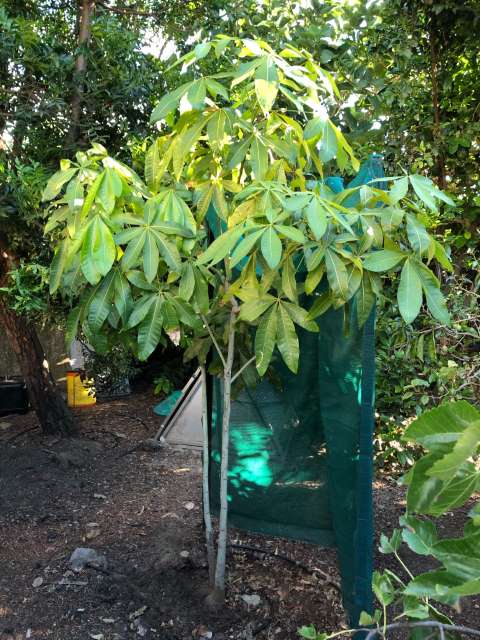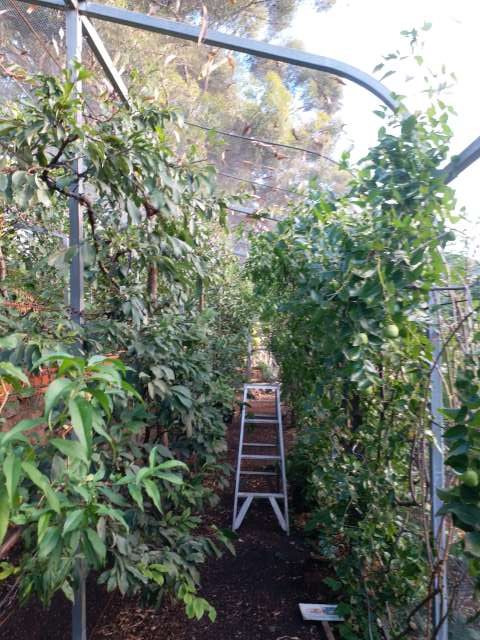Text and photos by Mike Bertram
I recently visited Robert Middleton’s magnificent “Midway Park” property and garden at Rosslyn Park. The 2758 square metre property has an interesting history dating back to the late 19th century.
The house is approximately 130 years old and is a typical example of a Victorian return-verandah Bluestone Villa. It is on the City of Burnside Local Heritage Register. The exact date it was built is unclear, but records show it was constructed by 1890 when it was known as ‘the Lord’s House’ – so called because it was home for 30 years to the Lord family; Mr John Lord, his wife Matilda and their 7 children.
The house and surrounding acres changed hands several times over the subsequent years, and it was owned for a time by Dr Roger Angove, a prominent Adelaide physician. Dr Angove sold the property to a real estate agent, Bill Henderson, who subsequently finalised a subdivision of the land and the City of Burnside named the Court in recognition of Dr Angove.
Robert bought the property in 2005 and about a year later went to a Rare Fruit Society meeting where the late Roger Meyer from California talked with enthusiasm about Jujubes. He was immediately hooked and bought several jujube trees – many other varieties of fruit trees followed.
During the initial stages of establishment at the time, he was experiencing drought conditions and water restrictions and he realised that if he was to continue acquiring trees he would need to collect and store water. As well as the cost saving, using rainwater produces healthier plants. To facilitate this, he had a 310,000 litre in-ground concrete water tank constructed in 2009. A 20kW solar system and battery powers a pump for irrigation and the underground storage will generally last for most of the year. The clay soil from the excavation was moved to what was then a tennis court on the northern side of the house, while above the tank loam was brought in and 105 roses planted. The soil above the tank is only 300mm deep and although much has been done to improve the texture and add nutrients the roses have struggled a little in hot weather, possibly because of their shallow root run.
The garden is distinguished by an extensive collection of fruit and nut trees with many different berry bushes including subtropical fruit and citrus trees, many of them unusual and considered to be difficult to grow in SA’s climatic conditions. To list just a few of nearly 70 different species, there are 6 varieties of bananas including Ducasse, Lady Finger, Silk and Plantain, avocados, guavas, chinotto, coffee, red and white dragon fruits, black and white sapotes, a jackfruit, custard apples and 20 different citrus including the rarely grown pomelos, and Malabar Chestnut or Sabah Nut. There are several subtropical species with fruit maturing currently including a mango, rose apple (a unique yellow fruit smelling like roses!), grapefruit, wax jambu, white and black sapotes, wampi, cumquats, capulin cherry, native tamarind, red tamarillo, and babaco. Temperate fruit and nuts close to ripening are pears, figs, apples, pecans, walnuts, and the jujubes. There are many varieties of each fruit, some of which are growing in an espaliered fruit enclosure.
A young longan, lychee, sapodilla and pawpaw grow close to the north facing verandah in a protected position, providing an ideal microclimate for their development.
Signs providing information about the fruit trees are displayed throughout the garden.
The selection of citrus, guavas and subtropical fruit trees were planted where the tennis court once was on the northern side of the property exposed to maximum sunlight throughout the year. Initially the planting holes were dug using an auger. Unfortunately, in the clay soil the action of the auger compacted the soil on the sides of the holes and created ‘sumps’ which held water and restricted the roots from expanding.
Following advice and help from a knowledgeable permaculturist, Robert was advised the trees would never grow successfully so he had most of the plants removed and re potted, grew a green manure crop which, with 3 truckloads of horse manure along with gypsum and organic products, was incorporated into the soil to help break up the clay and provide the trees with much needed minerals and microbes. Finally, after allowing time for the added organic matter to break down, the trees were replanted and have never looked back.
The effect of the better soil preparation was seen in a matter of months, with fruit trees such as the avocados, wampis, coffee, white sapotes and carambolas (star fruits) setting and holding fruit. The 20 different varieties of citrus also enjoyed the feed, darkening the leaves and cropping heavily.
Over the last 6 years Chris Day of Every Day Sustainable Living has helped with maintaining the garden. A lot of compost is produced on-site from mulched prunings, adding lawn clippings, green vegetable waste and poultry manure. Compost is added to the fruit trees in key times during the growing season. To bananas every 3 months during the warmer months resulting in a bunch or two maturing every month. In all it’s been a huge job for Robert and his team but in the long run, it’s been well worth the effort.
Robert has constructed a steel fruit ‘cage’ on the eastern side of his property enabling him to protect valuable crops like jujubes which he has espaliered along the western side. By using this training method he can accommodate more trees with 3 rows initially lining the cage. Later he doubled the depth and width to create an extra 3 rows making 6 rows, all fully enclosed now.
Many stone fruit like plums and peaches are also in the enclosure along with a subtropical canistel and mango. Grapes and figs are grown there as well. On the northern entrance to the enclosure, a large magnificent multi branching pitaya or dragon fruit drapes over the structure which at the time of my visit was flowering profusely.
A large walnut tree occupies the back garden near the fruit enclosure. A magnificent weeping mulberry is located nearby. Further to the south, there is a large quince tree with fruit nearing maturity.
On the south side of his property, Robert has had constructed an archway with a 50% shadecloth covering protecting a number of kiwifruit vines from the intense summer sun.
There are 2 Greenhouses that prove useful for starting off juvenile plants of sensitive species like Ambarella, Miracle fruit, Star apple, Soursop and Indian Gooseberry.
A real achievement succeeding growing these through winter even in a protected environment.
Robert acquired 2 beehives to assist with pollination and Belgian D’uccle bantams which control insect pests, weeds and continually contribute their nutrient rich manure. As well, mulch and organic foliar sprays are applied on a regular basis. Amongst the fruit trees is a pond that provides water for the bees as well as a developed bunch of water chestnuts – the grill on top of the pond is to stop baby chickens who free range under the trees from falling in!
Apart from fruiting plants, the garden has several rare flowering plants including the rare Michelia alba or Paklan. A treasured tree for its white perfumed flowers. Another is the night scented jasmine (Cestrum nocturnum). A collection of roses greets visitors in the front garden.
This wonderfully diverse garden showcases a vast variety of fruit and nut trees highlighting the many ways fruit can be grown in Adelaide’s temperate climate.
© Adapted from Rare Fruit Society Newsletter March 2022.












